Paper Menu >>
Journal Menu >>
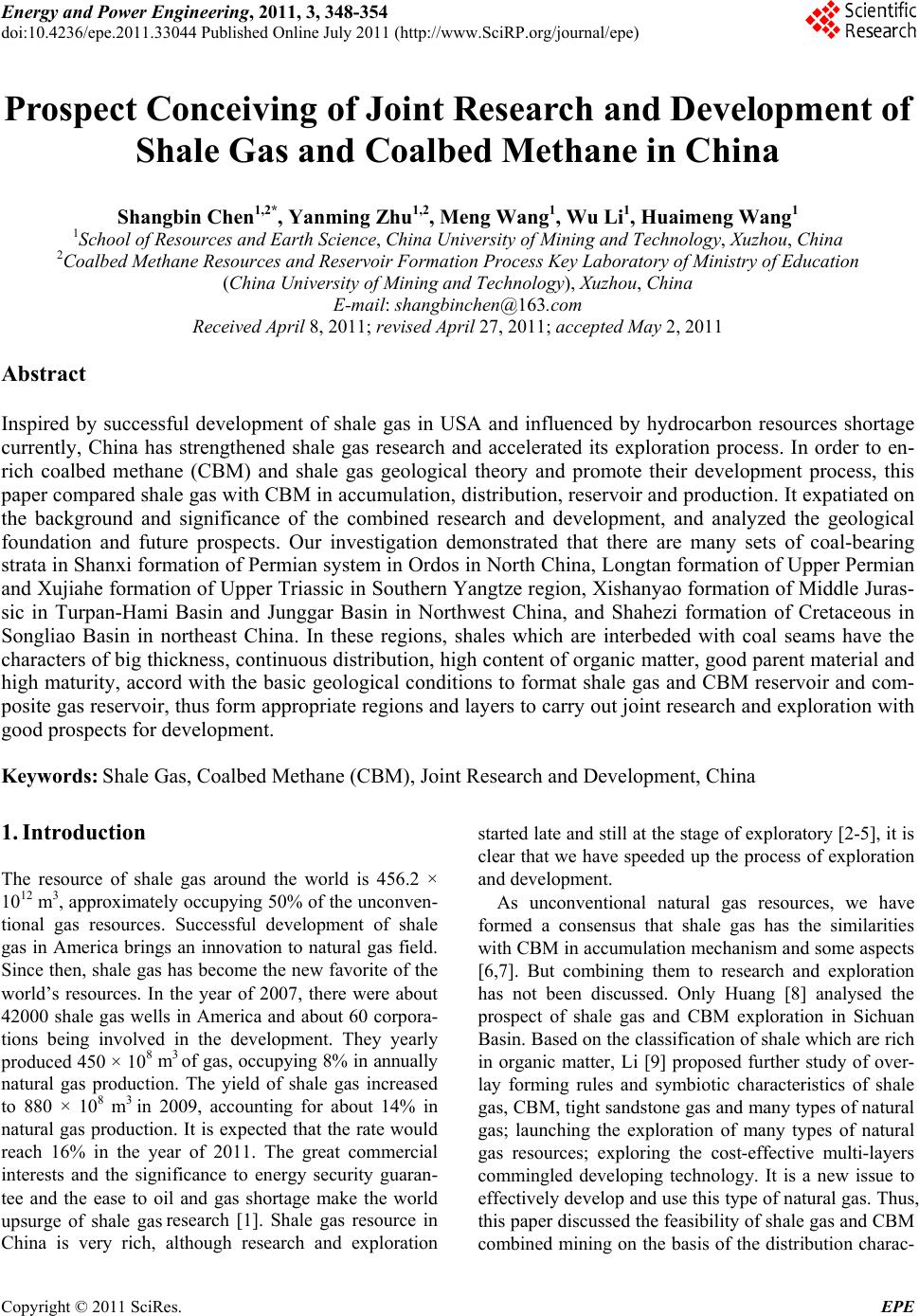 Energy and Power En gi neering, 2011, 3, 348-354 doi:10.4236/epe.2011.33044 Published Online July 2011 (http://www.SciRP.org/journal/epe) Copyright © 2011 SciRes. EPE Prospect Conceiving of Joint Research and Development of Shale Gas and Coalbed Methane in China Shangbin Chen1,2*, Yanming Zhu1,2, Meng Wang1, Wu Li1, Huaimeng Wang1 1School of Resources and Earth Science , China University of Mining and Technology, Xuzhou, China 2Coalbed Meth ane Resources and Reservoi r Formation Process Key Labo rat ory of Ministry of Education (China Univer si t y of Mining and Technolo g y ), Xuzhou, China E-mail: shangbinchen@163.com Received April 8, 2011; revised April 27, 2011; accepted May 2, 2011 Abstract Inspired by successful development of shale gas in USA and influenced by hydrocarbon resources shortage currently, China has strengthened shale gas research and accelerated its exploration process. In order to en- rich coalbed methane (CBM) and shale gas geological theory and promote their development process, this paper compared shale gas with CBM in accumulation, distribution, reservoir and production. It expatiated on the background and significance of the combined research and development, and analyzed the geological foundation and future prospects. Our investigation demonstrated that there are many sets of coal-bearing strata in Shanxi formation of Permian system in Ordos in North China, Longtan formation of Upper Permian and Xujiahe formation of Upper Triassic in Southern Yangtze region, Xishanyao formation of Middle Juras- sic in Turpan-Hami Basin and Junggar Basin in Northwest China, and Shahezi formation of Cretaceous in Songliao Basin in northeast China. In these regions, shales which are interbeded with coal seams have the characters of big thickness, continuous distribution, high content of organic matter, good parent material and high maturity, accord with the basic geological conditions to format shale gas and CBM reservoir and com- posite gas reservoir, thus form appropriate regions and layers to carry out joint research and exploration with good prospects for development. Keywords: Shale Gas, Coalbed Methane (CBM), Joint Research and Development, China 1. Introduction The resource of shale gas around the world is 456.2 × 1012 m3, approximately occupying 50% of the unconven- tional gas resources. Successful development of shale gas in America brings an innovation to natural gas field. Since then, shale gas has become the new favorite of the world’s resources. In the year of 2007, there were about 42000 shale gas wells in America and about 60 corpora- tions being involved in the development. They yearly produced 450 × 108 m3 of gas, occupying 8% in annually natural gas production. The yield of shale gas increased to 880 × 108 m3 in 2009, accounting for about 14% in natural gas production. It is expected that the rate would reach 16% in the year of 2011. The great commercial interests and the significance to energy security guaran- tee and the ease to oil and gas shortage make the world upsurge of shale gas research [1]. Shale gas resource in China is very rich, although research and exploration started late and still at the stage of exp loratory [2-5], it is clear that we have speeded up the process of exploration and development. As unconventional natural gas resources, we have formed a consensus that shale gas has the similarities with CBM in accumulation mechanism and some aspects [6,7]. But combining them to research and exploration has not been discussed. Only Huang [8] analysed the prospect of shale gas and CBM exploration in Sichuan Basin. Based on the classification of shale which are rich in organic matter, Li [9] proposed further study of over- lay forming rules and symbiotic characteristics of shale gas, CBM, tight sandstone gas and many types of natural gas; launching the exploration of many types of natural gas resources; exploring the cost-effective multi-layers commingled developing technology. It is a new issue to effectively develop and use this type of natural gas. Thus, this paper discussed the feasibility of shale gas and CBM combined mining on the basis of the distribution charac- 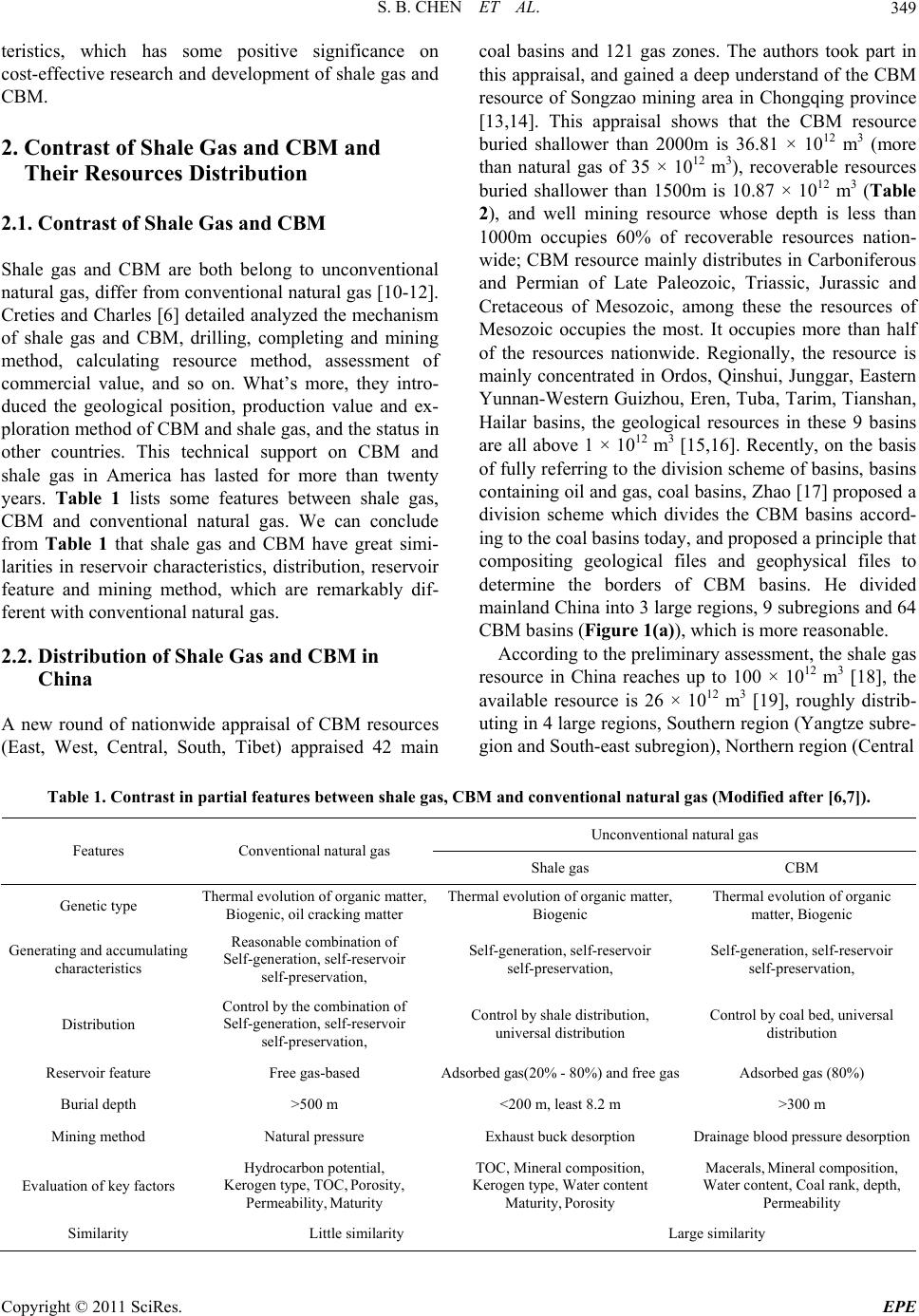 S. B. CHEN ET AL.349 teristics, which has some positive significance on cost-effective research and development of shale gas and CBM. 2. Contrast of Shale Gas and CBM and Their Resources Distribution 2.1. Contrast of Shale Gas and CBM Shale gas and CBM are both belong to unconventional natural gas, differ from conventional natural gas [10-12]. Creties and Charles [6] detailed analyzed the mechanism of shale gas and CBM, drilling, completing and mining method, calculating resource method, assessment of commercial value, and so on. What’s more, they intro- duced the geological position, production value and ex- ploration method of CBM and shale gas, and the status in other countries. This technical support on CBM and shale gas in America has lasted for more than twenty years. Table 1 lists some features between shale gas, CBM and conventional natural gas. We can conclude from Table 1 that shale gas and CBM have great simi- larities in reservoir characteristics, distribution, reservoir feature and mining method, which are remarkably dif- ferent with conventional natural gas. 2.2. Distribution of Shale Gas and CBM in China A new round of nationwide appraisal of CBM resources (East, West, Central, South, Tibet) appraised 42 main coal basins and 121 gas zones. The authors took part in this appraisal, and gained a deep unders tand of the CBM resource of Songzao mining area in Chongqing province [13,14]. This appraisal shows that the CBM resource buried shallower than 2000m is 36.81 × 1012 m3 (more than natural gas of 35 × 1012 m3), recoverable resources buried shallower than 1500m is 10.87 × 1012 m3 (Table 2), and well mining resource whose depth is less than 1000m occupies 60% of recoverable resources nation- wide; CBM resource mainly distributes in Carboniferous and Permian of Late Paleozoic, Triassic, Jurassic and Cretaceous of Mesozoic, among these the resources of Mesozoic occupies the most. It occupies more than half of the resources nationwide. Regionally, the resource is mainly concentrated in Ordos, Qinshui, Junggar, Eastern Yunnan-Western Guizhou , Eren, Tuba, Tarim, Tianshan, Hailar basins, the geological resources in these 9 basins are all above 1 × 1012 m3 [15,16]. Recently, on the basis of fully referring to the division scheme of basins, basins containing oil and gas, coal basins, Zhao [17] proposed a division scheme which divides the CBM basins accord- ing to the coal basins today, and proposed a principle that compositing geological files and geophysical files to determine the borders of CBM basins. He divided mainland China in to 3 large regions, 9 su bregions and 64 CBM basins (Figure 1(a)), which is more reasonable. According to the preliminary assessment, the shale gas resource in China reaches up to 100 × 1012 m3 [18], the available resource is 26 × 1012 m3 [19], roughly distrib- uting in 4 large regions, Southern region (Yangtze subre- gion and Sou th-east subregion), Northern region (Central Table 1. Contrast in partial features between shale gas, CBM and conventional natural gas (Modified after [6,7]). Unconventional natural gas Features Conventional natural gas Shale gas CBM Genetic type Thermal evoluti on of organic matter, Biogenic, oil cracking matter Thermal evoluti on of organic matter, Biogenic Thermal evolution of organic matter, Biogenic Generating and accumulating characteristics Reasonable combination of Self-generation, self-reservoir self-preservation, Self-generation, self-reservoir self-preservation, Self-generation, self-reservoir self-preservation, Distribution Control by the combination of Self-generation, self-reservoir self-preservation, Control by shale distribution, universal distribution Control by coal bed, universal distribution Reservoir feature Free gas-based Adsorbed gas(20% - 80%) and f ree gasAdsorbed gas (80%) Burial depth >500 m <200 m, least 8.2 m >300 m Mining method Natural pressure Exhaust buck desorption Drainage blood pressure desorpti on Evaluation of key factors Hydrocarbon potential, Kerogen type, TOC, Porosity, Permeability, Maturity TOC, Mineral composition, Kerogen type, Water content Maturity, Porosity Macerals, Mineral composition, Water content, Coal rank, depth, Permeability Similarity Little similarity Large similarity Copyright © 2011 SciRes. EPE  S. B. CHEN ET AL. 350 Table 2. Comparison of resource distribution between CBM and shale gas in China. Geological resource reserves Recoverable resources Recoverable resources Type Zoning ×1012 m3 Proportion (%) ×1012 m3 Proportion (%)Type Zoning ×1012 m3 Proportion (%) Northern 11.32 30.8 4.32 39.7 North-east 10.47 28.4 2.00 18.4 Northern 2.31 8.9 North-west 10.36 28.1 2.86 26.3 North-west 11.18 43 Southern 4.66 12.3 1.70 15.6 Southern 12.17 46.8 CBM Qinghai-Tibet 0 0 0 0 Shale gas Qinghai-Tibet 0.34 1.3 Total 36 - 10.9 - Total 26 - (Notes: (a) Recov erab le r eso ur ces o f s hale g as are acco rd ing to Zh ang et al. [19]; (b) In CBM resource evaluation, the resource of Qinghai-Tibet region is 0 for topographic conditions; (c) The geological resource reserves is depth less than 2000 m, and the recoverable resource is depth less than 1500 m.) subregion, North-east subregion and East subregion), North-west region (Northern subregion, Southern subre- gion and Qaidam subregion) and the Qinghai-Tibet re- gion. Southern region mainly develops shale gas of Cambrian, Silurian and Permian. Northern region mainly forms shale gas of Ordovician, Carboniferous and Per- mian. North-west region mainly forms shale gas of Late Permian and Mesozoic. Qinghai-Tibet region develops marine shale gas of Paleozoic and Mesozoic, but it’s only regarded as favorable prospects region for its geo- graphical conditions (Figure 1(b)). According to the distribution feature of CBM and shale gas resource in China, Carboniferous and Permian system of Late Paleozoic, Triassic, Jurassic, Cretaceous system of Mesozoic and other coal-bearing strata and clay shale can generate and store shale gas and CBM at the same time, the feature of resource distribution has overlapping and compound character. 3. Significance of Joint Exploring Shale Gas and CBM Firstly, CBM in China has developed into the commer- cialization stage [20-22], but the range is not wide enough, there are plenty of key technical problems have not being overcome yet, which need more extensive re- search to consummate. Meanwhile, shale researches are started up recently; there are a series of similarities be- tween CBM and shale gas in accumulation, development and resource distribution, etc. Secondly, as mentioned in 2.2, interbedded shale which are rich in organic matter and coal or thin coal seam are widespread in late Paleozoic and Mesozoic strata in china, satisfying the essential geological condition to carry out the combined research on shale gas and CBM. According to the successful development of shale gas in United States [11,23,24], shale buried in the depth of 183 - 2591 m (the buried depth of east basin between Delaware and Texas is 3450 - 5562 m and 3352 - 3962.4 m respec- tively) in the main basin (Fort Worth, Appalachian, Michigan, Illinois and San Juan), mostly less than 1500 m, are relatively shallow and approaching to the rich layer of CBM exploitation. And now in the current re- search shale samples are mostly from surface or near the surface [9], both have geological, exploitable and ex- perimental basis to combined research and development. Thirdly, for shale gas is in infancy stage in china, there are a lot of limitations: drilling wells directly conducted for shale gas exploration (air testing, well testing, etc.) are very few; research data are primarily acquired from convention al oil & gas, CBM, and solid mineral explora- tion data [9]. First shale gas co ring shallow well in China (designed and implemented by RIPED), Changxin-1 well in Yibin, Sichuan Province, was successfully finished on November 26, 2008, for the Silurian shale core samples and test data [25]. The first domestic shale gas explora- tion wells started in Lianhu town Pengshui Miao and Tujia Autonomous Coun ty of Chongqing, by Ministry of Land and Oil and Gas Resources Strategic Research Centre and China University of Geosciences (Beijing), on November 28, 2009, indicates the formal implemen- tation of shale gas exploration in china. For only two wells currently, it is very weak for accurate assessment of shale gas and related research. Finally, shale gas has a lot in common with conven- tional hydrocarbon resources in generating, and the data of conventional oil and gas source rocks has a great ref- erence, but in reservoir, especially in mining technology, there are great differences. So it’s necessary to learn the experience and skills of CBM, especially in reservoir requirements, development of fracturing and horizontal well technology, which lay a perfect foundation for the combined research on shale gas and CBM. Meanwhile, CBM research in China has made a significant achieve- ment as well as commercial development [20,22], so the combined research can learn from home and aboard, par Copyright © 2011 SciRes. EPE 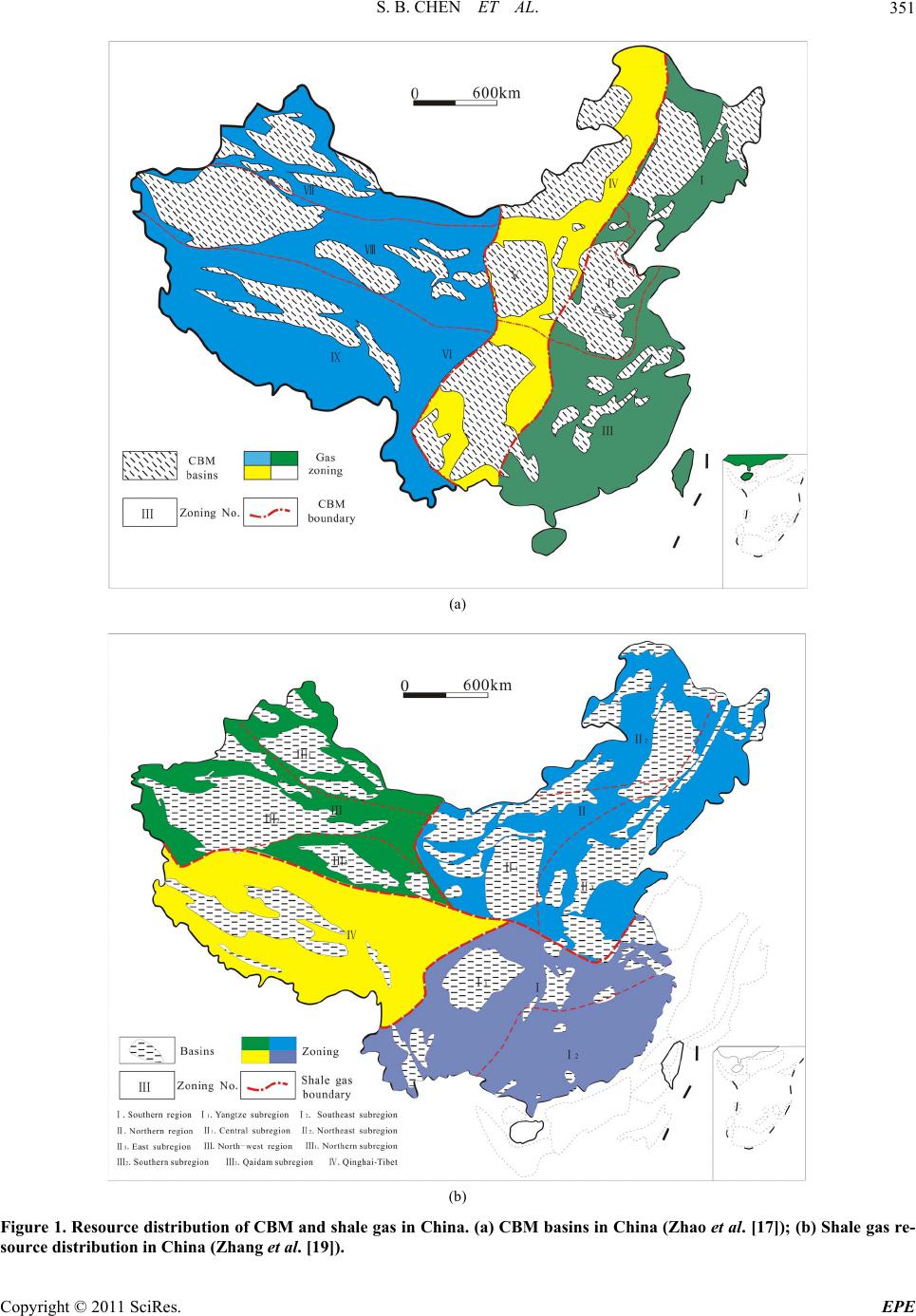 S. B. CHEN ET AL.351 (a) (b) Figure 1. Resource distri bution of CBM and shale gas in China. (a) CBM basins in China (Zhao et al. [17]); (b) Shale gas re- ource distribution in China (Zhang et al. [19]). s Copyright © 2011 SciRes. EPE 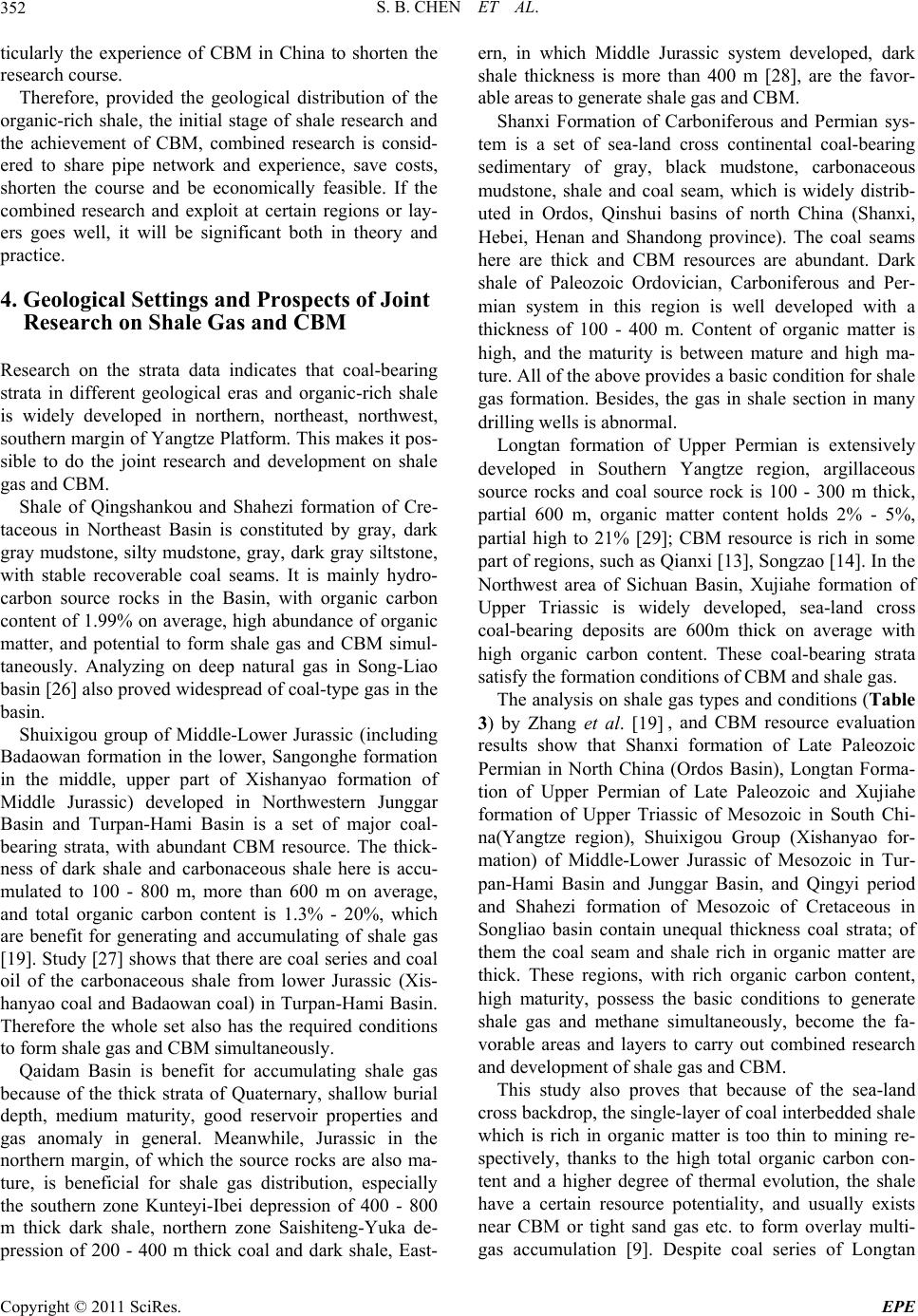 S. B. CHEN ET AL. Copyright © 2011 SciRes. EPE 352 ticularly the experience of CBM in China to shorten the research course. Therefore, provided the geological distribution of the organic-rich shale, the initial stage of shale research and the achievement of CBM, combined research is consid- ered to share pipe network and experience, save costs, shorten the course and be economically feasible. If the combined research and exploit at certain regions or lay- ers goes well, it will be significant both in theory and practice. 4. Geological Settings and Prospects of Joint Research on Shale Gas and CBM Research on the strata data indicates that coal-bearing strata in different geological eras and organic-rich shale is widely developed in northern, northeast, northwest, southern margin of Yangtze Platform. This makes it pos- sible to do the joint research and development on shale gas and CBM. Shale of Qingshankou and Shahezi formation of Cre- taceous in Northeast Basin is constituted by gray, dark gray mudstone, silty mudstone, gray, dark gray siltstone, with stable recoverable coal seams. It is mainly hydro- carbon source rocks in the Basin, with organic carbon content of 1.99% on average, high abundance of organic matter, and potential to form shale gas and CBM simul- taneously. Analyzing on deep natural gas in Song-Liao basin [26] also proved widespread of coal-type gas in the basin. Shuixigou group of Middle-Lower Jurassic (including Badaowan formation in the lower, Sangonghe formation in the middle, upper part of Xishanyao formation of Middle Jurassic) developed in Northwestern Junggar Basin and Turpan-Hami Basin is a set of major coal- bearing strata, with abundant CBM resource. The thick- ness of dark shale and carbonaceous shale here is accu- mulated to 100 - 800 m, more than 600 m on average, and total organic carbon content is 1.3% - 20%, which are benefit for generating and accumulating of shale gas [19]. Study [27] shows that there are coal series and coal oil of the carbonaceous shale from lower Jurassic (Xis- hanyao coal and Badaowan coal) in Turpan-Hami Basin. Therefore the whole set also has the required conditions to form shale gas and CBM simultaneously. Qaidam Basin is benefit for accumulating shale gas because of the thick strata of Quaternary, shallow burial depth, medium maturity, good reservoir properties and gas anomaly in general. Meanwhile, Jurassic in the northern margin, of which the source rocks are also ma- ture, is beneficial for shale gas distribution, especially the southern zone Kunteyi-Ibei depression of 400 - 800 m thick dark shale, northern zone Saishiteng-Yuka de- pression of 200 - 400 m thick coal and dark shale, East- ern, in which Middle Jurassic system developed, dark shale thickness is more than 400 m [28], are the favor- able areas to generate shale gas and CBM. Shanxi Formation of Carboniferous and Permian sys- tem is a set of sea-land cross continental coal-bearing sedimentary of gray, black mudstone, carbonaceous mudstone, shale and coal seam, which is widely distrib- uted in Ordos, Qinshui basins of north China (Shanxi, Hebei, Henan and Shandong province). The coal seams here are thick and CBM resources are abundant. Dark shale of Paleozoic Ordovician, Carboniferous and Per- mian system in this region is well developed with a thickness of 100 - 400 m. Content of organic matter is high, and the maturity is between mature and high ma- ture. All of the above provides a ba sic cond ition for sh ale gas formation. Besides, the gas in shale section in many drilling wells is abnormal. Longtan formation of Upper Permian is extensively developed in Southern Yangtze region, argillaceous source rocks and coal source rock is 100 - 300 m thick, partial 600 m, organic matter content holds 2% - 5%, partial high to 21% [29]; CBM resource is rich in some part of regions, such as Qianxi [13], Songzao [14]. In the Northwest area of Sichuan Basin, Xujiahe formation of Upper Triassic is widely developed, sea-land cross coal-bearing deposits are 600m thick on average with high organic carbon content. These coal-bearing strata satisfy the formation conditio ns of CBM and shale gas. The analysis on shale gas types and conditions (Table 3) by Zhang et al. [19] , and CBM resource evaluation results show that Shanxi formation of Late Paleozoic Permian in North China (Ordos Basin), Longtan Forma- tion of Upper Permian of Late Paleozoic and Xujiahe formation of Upper Triassic of Mesozoic in South Chi- na(Yangtze region), Shuixigou Group (Xishanyao for- mation) of Middle-Lower Jurassic of Mesozoic in Tur- pan-Hami Basin and Junggar Basin, and Qingyi period and Shahezi formation of Mesozoic of Cretaceous in Songliao basin contain unequal thickness coal strata; of them the coal seam and shale rich in organic matter are thick. These regions, with rich organic carbon content, high maturity, possess the basic conditions to generate shale gas and methane simultaneously, become the fa- vorable areas and layers to carry out combined research and development of shale gas and CBM. This study also proves that because of the sea-land cross backdrop, the single-layer of coal interbedded shale which is rich in organic matter is too thin to mining re- spectively, thanks to the high total organic carbon con- tent and a higher degree of thermal evolution, the shale have a certain resource potentiality, and usually exists near CBM or tight sand gas etc. to form overlay multi- gas accumulation [9]. Despi e coal series of Longtan t 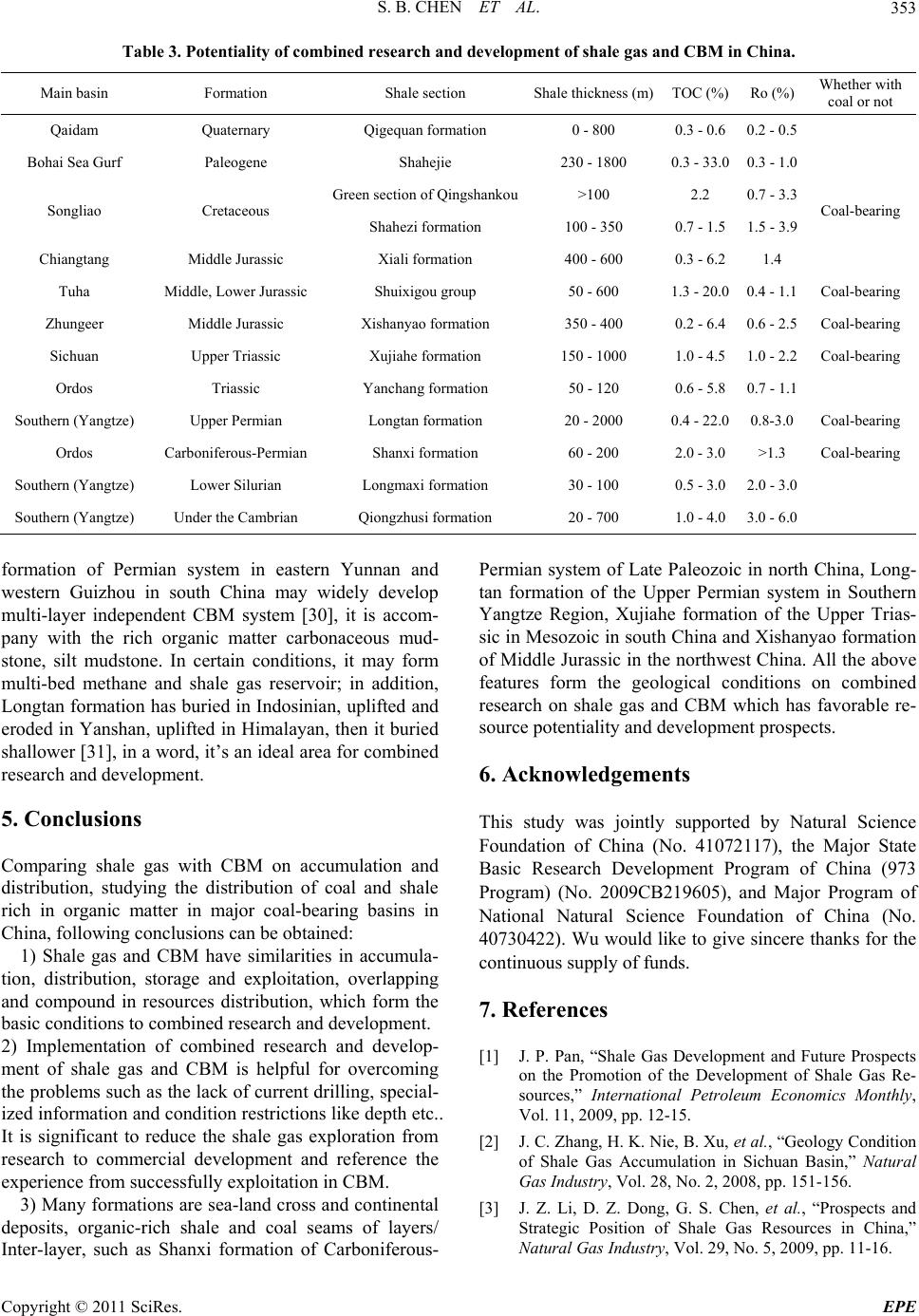 S. B. CHEN ET AL.353 Table 3. Potentiality of combined research and development of shale gas and CBM in China. Main basin Formation Shale section Shale thickness (m)TOC (%) Ro (%) Whether with coal or not Qaidam Quaternary Qigequan formation 0 - 800 0.3 - 0.6 0.2 - 0.5 Bohai Sea Gurf Paleogene Shahejie 230 - 1800 0.3 - 33.0 0.3 - 1.0 Green section of Qingshankou>100 2.2 0.7 - 3.3 Songliao Cretaceous Shahezi formation 100 - 350 0.7 - 1.5 1.5 - 3.9 Coal-bearing Chiangtang Middle Jurassic Xiali formation 400 - 600 0.3 - 6.2 1.4 Tuha Middle, Lower Jurassic Shuixigou group 50 - 600 1.3 - 20.0 0.4 - 1.1 Coal-bearing Zhungeer Middle Jurassic Xishanyao formation 350 - 400 0.2 - 6 .4 0.6 - 2.5 Coal-bearing Sichuan Upper Triassic Xujiahe formation 150 - 1000 1.0 - 4.5 1.0 - 2.2 Coal-bearing Ordos Triassic Yanchang form a t i o n 50 - 120 0.6 - 5.8 0.7 - 1.1 Southern (Yangtze) Upper Permian Longtan formation 20 - 2000 0.4 - 22.0 0.8-3.0 Coal-bearing Ordos Carboniferous-Permian Shanxi formation 60 - 200 2.0 - 3.0 >1.3 Coal-bearing Southern (Yangtze) Lower Silurian Longmaxi formation 30 - 100 0.5 - 3.0 2.0 - 3.0 Southern (Yangtze) Under the Cambrian Qiongzhusi formation 20 - 700 1.0 - 4.0 3.0 - 6.0 formation of Permian system in eastern Yunnan and western Guizhou in south China may widely develop multi-layer independent CBM system [30], it is accom- pany with the rich organic matter carbonaceous mud- stone, silt mudstone. In certain conditions, it may form multi-bed methane and shale gas reservoir; in addition, Longtan formation has buried in Indosinian, uplifted and eroded in Yanshan, uplifted in Himalayan, then it buried shallower [31], in a word, it’s an ideal area for combined research and development. 5. Conclusions Comparing shale gas with CBM on accumulation and distribution, studying the distribution of coal and shale rich in organic matter in major coal-bearing basins in China, following conc lusions can be obtained: 1) Shale gas and CBM have similarities in accumula- tion, distribution, storage and exploitation, overlapping and compound in resources distribution, which form the basic conditions to combined research and development. 2) Implementation of combined research and develop- ment of shale gas and CBM is helpful for overcoming the problems such as the lack of current drilling, special- ized information and condition restrictions like depth etc.. It is significant to reduce the shale gas exploration from research to commercial development and reference the experience from successfully exploitation in CBM. 3) Many formations are sea-land cross and continental deposits, organic-rich shale and coal seams of layers/ Inter-layer, such as Shanxi formation of Carboniferous- Permian system of Late Paleozoic in north China, Long- tan formation of the Upper Permian system in Southern Yangtze Region, Xujiahe formation of the Upper Trias- sic in Mesozoic in south China and Xishanyao formation of Middle Jurassic in the northwest China. All the above features form the geological conditions on combined research on shale gas and CBM which has favorable re- source potentiality and development prospects. 6. Acknowledgements This study was jointly supported by Natural Science Foundation of China (No. 41072117), the Major State Basic Research Development Program of China (973 Program) (No. 2009CB219605), and Major Program of National Natural Science Foundation of China (No. 40730422). Wu would like to give sincere thanks for the continuous supp ly of funds. 7. References [1] J. P. Pan, “Shale Gas Development and Future Prospects on the Promotion of the Development of Shale Gas Re- sources,” International Petroleum Economics Monthly, Vol. 11, 2009, pp. 12-15. [2] J. C. Zhang, H. K. Nie, B. Xu, et al., “Geology Condition of Shale Gas Accumulation in Sichuan Basin,” Natural Gas Industry, Vol. 28, No. 2, 2008, pp. 151-156. [3] J. Z. Li, D. Z. Dong, G. S. Chen, et al., “Prospects and Strategic Position of Shale Gas Resources in China,” Natural Gas Industry, Vol. 29, No. 5, 2009, pp. 11-16. Copyright © 2011 SciRes. EPE  S. B. CHEN ET AL. 354 [4] R. F. Pan and X. S. Huang, “Shale Gas and Domestic Exploration Prospect,” China Petroleum Exploration, Vol. 14, No. 3, 2009, pp. 1-5. [5] S. B. Chen, Y. M. Zhu, H. Y. Wang, et al., “Research Status and Trends of Shale Gas in China,” Acta Petrolei Sinica, Vol. 31, No. 4, 2010, pp. 689-694. [6] D. J. Creties and M. B. Charles, “Coalbed and Shale Gas Reservoirs,” Journal of Petroleum Technology, Vol. 60, No. 2, 2008, pp. 92-99. [7] H. Y. Jiang, X. M. Song, X. X. An, et al., “Current State and Outlook of Exploration and Development of the Shale Gas Resources in the World,” Petroleum Geology & Oilfield Development in Daqing, Vol. 27, No. 6, 2008, pp. 10-14. [8] J. Z. Huang, “Exploration Prospect of Shale Gas and Coal-Bed Methane in Sichuan Basin,” Lithologic Reser- voirs, Vol. 21, No. 2, 2009, pp. 116-120. [9] Y. X. Li, H. K. Nie and P. Y. Long, “Development Char- acteristics of Organic-Rich Shale and Strategic Selection of Shale Gas Exploration Area in China,” Natural Gas Industry, Vol. 29, No. 12, 2009, pp. 115-118. [10] B. E. Law and J. B. Curtis, “Introduction to Unconven- tional Petroleum Systems,” American Association of Pe- troleum Geologists Bulletin, Vol. 86, No. 11, 2002, pp. 1851-1852. [11] J. B. Curtis, “Fractured Shale-Gas Systems,” American Association of Petroleum Geologists Bulletin, Vol. 86, No. 11, 2002, pp. 1921-1938. [12] W. B. Ayers Jr., “Coalbed Gas Systems, Resources, and Production and a Review of Contrasting Cases from the San Juan and Powder River Basins,” American Associa- tion of Petroleum Geologists Bulletin, Vol. 86, No. 11, 2002, pp. 1853-1890. [13] Y. Qin, S. X. Sang, X. H. Fu, et al., “Potentials of CBM Resources in Key Coal Mining Areas in China and Some Theoretical Problems in Resources Evaluation,” China Coalbed Methane, Vol. 3, No. 4, 2006, pp. 17-20. [14] S. B. Chen, Y. M. Zhu, X. H. Wang, et al., “Study on Coal Bed Methane Deposit Features of Yangchatan Coal- field in Songzao Mining Area,” Coal Science and Tech- nology, Vol. 36, No. 8, 2008, pp. 91-95. [15] C. B. Che, H. L. Yang, F. B. Li, et al., “Exploration and Development Prospects of Coal Bed Methane (CBM) Resources in China,” China Mining Magazine, Vol. 17, No. 5, 2008, pp. 1-4. [16] C. L. Liu, J. Zhu, C. B. Che, et al., “Methodologies and Results of the Latest Assessment of Coalbed Methane Resources in China,” Natural Gas Industry, Vol. 29, No. 11, 2009, pp. 140-132. [17] J. Z. Zhao, L. J. Song and B. H. Shi, “Divisional Princi- ples and Projects of Coalbed Methane Basin in Mainland China,” Acta Geologica Sinica, Vol. 82, No. 10, 2008, pp. 1402-1407. [18] H. Y. Wang, J. M. Li, Q. Zhao, et al., “Resources and Development of New Energy in China,” Acta Petrolei Sinica, Vol. 30, No. 3, 2009, pp. 469-474. [19] J. C. Zhang, S. L. Jiang, X. Tang, et al., “Accumulation Types and Resources Characteristics of Shale Gas in China,” Natural Gas Industry, Vol. 29, No. 12, 2009, pp. 109-114. [20] J. P. Ye, “Advances in Exploration and Development of Coalbed Methane in China: A Review,” Geological Bul- letin of China, Vol. 25, No. 9-10, 2006, pp. 1074-1078. [21] Y. Qin and A. G. Chen, “CBM Exploration and Exploita- tion Advances and Trend in China,” Coal Geology of China, Vol. 19, No. 1, 2007, pp. 26-29. [22] K. Qian, Z. S. Shi, S. G. Lin, et al., “Industrialization Progression and Development Suggestions for Coalbed Methane of China,” Natural gas geosciences, Vol. 20, No. 6, 2009, pp. 831-840. [23] D. F. Martineau, “History of the Newark East Field and the Barnett Shale as a Gas Reservoir,” AAPG Bulletin, Vol. 91, No. 4, 2007, pp. 399-403. doi:10.1306/intro910407 [24] D. M. Jarvie, R. J. Hill, T. E. Ruble, et al., “Unconven- tional Shale-Gas Systems: The Mississippian Barnett Shale of North-Central Texas as One Mondel for Ther- mogenic Shale-Gas Assessment,” American Association of Petroleum Geologists Bulletin, Vol. 91, No. 4, 2007, pp. 475-499. doi:10.1306/12190606068 [25] S. J. Wang, L. S. Wang, J. L. Huang, et al., “Accumula- tion Conditions of Shale Gas Reservoirs in Silurian of the Upper Yangtze Region,” Natural Gas Industry, Vol. 29, No. 5, 2009, pp. 45-50. [26] X. Luo, F. J. Sun, M. L. Shao, et al., “Geochemistry of Deep Coal-Type Gas and Gas Source Rocks in Songliao Basin,” Petroleum Exploration and Development, Vol. 36, No. 3, 2009, pp. 339-346. [27] K. M. Cheng, Y. Xiong, X. M. Zeng, et al., “Coal into Hydrocarbons in Turpan-Hami Basin,” Acta Petrolei Sinica, Vol. 23, No. 4, 2002, pp. 13-17. [28] D. Y. Cao, W. F. Zhan, T. J. Liu, et al., “Tectonic Divi- sions and Distribution Rules for Coal Measures in North- ern Qaidam Basin,” Geotectonica et Metallogenia, Vol. 31, No. 3, 2007, pp. 322-327. [29] D. G. Liang, T. L. Guo, L. Z. Bian, et al., “Some Progress on Studies of Hydrocarbon Generation and Accumulation in Marine Sedimentary Regions, Southern China (Part1): Distribution of Four Suits of Regional Marine Source Rocks,” Marine Petroleum Geology , Vol. 13, No. 2, 2008, pp. 1-16. [30] Y. Qin, M. H. Xiong, T. S. Yi, et al., “On Unattac hed Mul- tiple Superposed Coalbed-Methane System: In a Case of the Suigonghe Syncline, Zhijin-Nayong Coalfield, Gui-zhou,” Geological Review, Vol. 54, No. 1, 2008, pp. 65-69. [31] Y. M. Zhu, H. Zhao, Q. L. Yan, et al., “Tectonic Evolu- tion and CBM Reservoir Formation in Wulunshan Mine- field, Guizhou,” Coal Geology of China, Vol. 20, No. 10, 2008, pp. 38-41. Copyright © 2011 SciRes. EPE |

